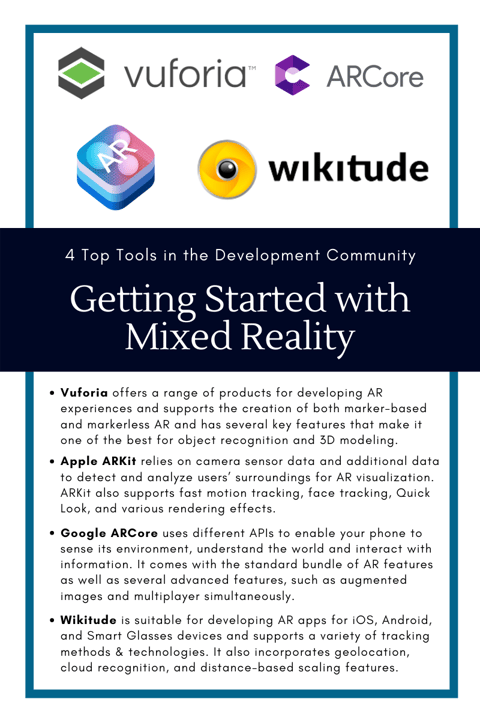Augmented Reality (AR) is one of the most impressive and growing technologies of 2021. With an audience of 810 million active AR users on mobile, the potential engagement that can be captured by AR features and products cannot be understated (Statista, March 2021). When it comes to complex apps that incorporate 3D graphics, advanced functionality and innovative technologies like AR, the development process can seem like a hopelessly tangled web of complexity.

AR SDKs (Software Development Kits) are essentially a bundle of programs and software used to develop other software. The main advantage of them is that they allow developers to apply time-tested solutions and shortcuts in development, instead of solving all generic and typical problems individually. Below, we explore 4 of the top tools for AR creation that are popular and valued in the AR development community.
- Vuforia - According to their site, “Vuforia provides the fastest, easiest and most advanced AR content development solutions to help industrial enterprise customers address workforce challenges and meet business goals.” Vuforia offers a range of products for developing AR experiences, including Vuforia Engine, Studio, and Chalk. The software supports the creation of both marker-based and markerless AR and has several key features that make it one of the best for object recognition and 3D modeling. These features include Ground Plane (for adding content to horizontal surfaces), Visual Camera (expands supported visual sources beyond mobile phones and tablets), and VuMarks (custom markers that can be used in Vuforia face recognition and also encode data).
- Apple ARKit - ARKit is the go-to application for the development of AR software developed by Apple, so it is not possible to use ARKit on android phones. The software relies on camera sensor data and additional data to detect and analyze users’ surroundings for AR visualization. ARKit also supports fast motion tracking, face tracking, Quick Look, and various rendering effects. Apple has worked hard to keep AR easy and understandable for developers, releasing ARKit tutorial materials and updates (ARKit 1.5 , ARKit 2 , ARKit 3) with every new version of iOS.
- Google ARCore - Google’s platform for building augmented reality experiences, ARCore, uses different APIs to enable your phone to sense its environment, understand the world and interact with information. Some of the APIs are even available across Android and iOS to enable shared AR experiences. ARCore comes with the standard bundle of AR features (motion tracking, surface detection, light estimation), as well as several advanced features, such as augmented images (custom responses to specific types of 2D shapes and objects) and multiplayer (rendering of the same 3D objects on different devices simultaneously. It is also worth mentioning that ARCore is compatible with Vuforia, which allows users to make the best of functionality offered by the 2 types of software at once.
- Wikitude - Wikitude is another great choice for AR software development. It is a relative newcomer to the market, with the company being founded in 2008, but has already earned a solid reputation. In fact, the debate of Vuforia vs Wikitude has become quite active recently. Wikitude is suitable for developing AR apps for iOS, Android, and Smart Glasses devices. Like most top AR development programs, Wikitude supports a variety of tracking methods and technologies, but also incorporates geolocation, cloud recognition, and distance-based scaling features.
All of the aforementioned applications are well-respected among developers, and all of them have their own strengths and weaknesses, which mostly consist of supported and non-supported functions. In order to build your AR application, you should choose the tools that will best correspond to your needs. This means focusing on functionality and ease in development instead of picking the most advertised or flashy software.
If you're new to mixed reality, it's important you start from the bottom and work your way up through its core concepts, experiences, and capabilities. This approach will help you set a firm foundation for designing and developing your own ideas in Mixed Reality. Begin your Mixed Reality journey using the resources we've laid out below:
- Microsoft Learn - Discover new skills and find certifications with interactive, hands-on learning paths. Learn modules help you become proficient in Mixed Reality development, offering a module-based structure to get you started with key tools like Mixed Reality Toolkit, Unity, and Azure mixed reality services.
- Microsoft MRTK Tutorial Series - If you're more of a learn-by-doing user, check out the Mixed Reality Toolkit (MRTK) tutorial series. You'll build a mixed reality experience where the user can explore a hologram modeled after NASA's Mars Curiosity Rover and get a firm grasp of MRTK and how it can speed up your development process.
- Microsoft Self-guided exploration - If you're a seasoned developer and want to get right into our docs, start by installing the required tools. From there, choose your Unity development setup and follow our curated Unity development path with HoloLens or browse around our content library.
- Upskill Skylight Docs - build scalable enterprise apps for wearable, augmented reality, and mobile devices. Using low-code development tools, a robust set of platform features, and quick start apps for common use cases, you can quickly develop, deploy, and manage apps that are tailored to your organization’s specific needs and integrate with enterprise systems.
Finally, if you are hiring a company to develop your AR application, you must make sure that they have the experience necessary to create value and align AR with business goals. Our team is uniquely qualified to handle full-cycle AR development:
